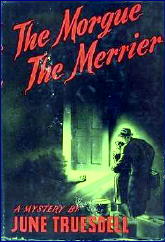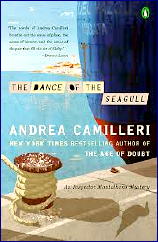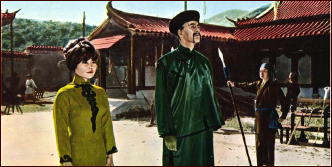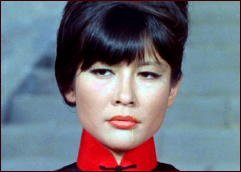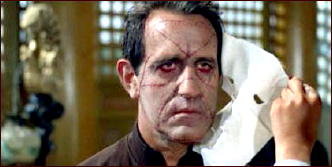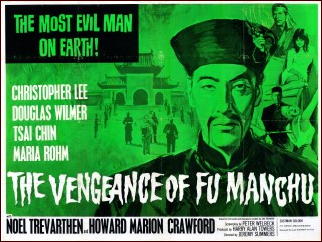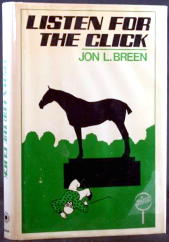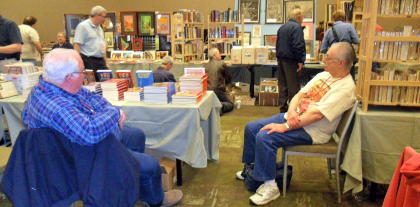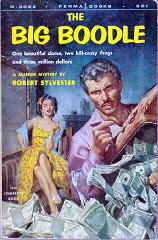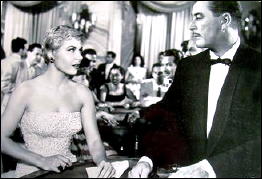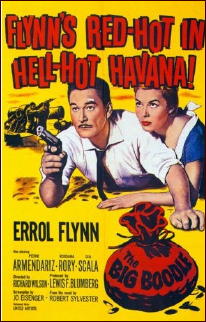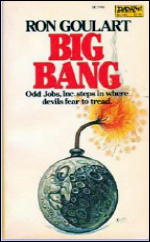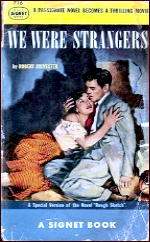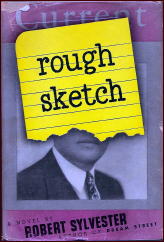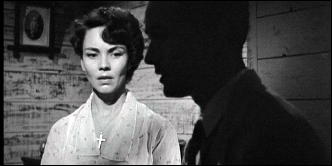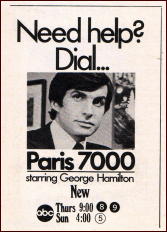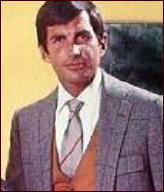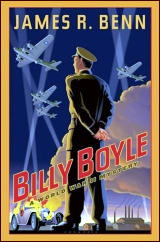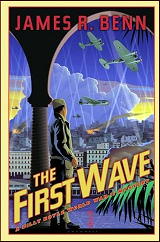WINDY CITY PULP CONVENTION 2013 REPORT
by Walker Martin
Once again the usual gang of veteran collectors rented a 12-seat van for the long trip to Chicago. I’m talking about our annual pilgrimage to the Windy City Pulp Convention which was held over the weekend of April 12-14, 2013. But three days were not enough for us so we left the morning of April 10 and arrived 14 hours later.
We were to stay a total of five days eating meals together, some of us rooming together, competing against each other for books, magazines, artwork, and generally bumping heads, fighting, and insulting each other. You might wonder how five collectors could survive such an intense trip. I wonder about this also but somehow we managed to get through the ordeal of roaming through a gigantic room of 150 tables, most of them piled high with stacks of books, pulps, digests, slicks, pulp reprints, and artwork.
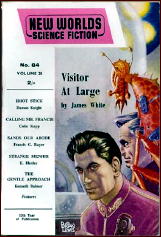
I always sleep poorly at the pulp conventions and I guess I averaged 4 or 5 hours sleep each night. The rooms at the Westin Hotel are nice and the convention rate is really low each night, only $109 plus taxes. I would have stayed longer but everyone else had packed up their books and pulps and left. The first day we arose early and continued our practice of eating breakfast each morning at the Egg Harbor Cafe. We devour everything in sight and thus do not have to leave the dealer’s room for lunch and waste valuable time when we could be buying and selling books.
Thursday we again visited The Doug Ellis and Deb Fulton Pulp Art Exhibit. They also happen to live in this art museum. We have visited the museum for three years in a row and this year we saw the new expansion. However, we got lost driving back to the hotel and spent a couple hours blaming each other for such stupidity, so this may be the end of the visits to the Art Exhibit.
Friday was the official beginning of the festivities. Dealers were allowed in at 8:30 but since I had an “early bird” badge, I started to harass and bother the dealers at 9:30, thus beating the poor souls who had to wait until 11:00. Since I no longer need many pulps, I’m mainly interested in pulp art and cover paintings. I made my first buy at Bob Weinberg’s table. I’ve known Bob since the late 1960’s when we both lived in NJ and used to meet at the NYC SF conventions. Despite the news that he was having some health problems, he was at this table each day and walked around the dealer’s room.
While I was talking to Bob, I noticed a cover painting by Brian Lewis for NEW WORLDS #84 (June 1959). I quickly snapped it up because I’ve recently been reading through my sets of NEW WORLDS and SCIENCE FANTASY because of the recent publication of three excellent books on these two British magazines edited by John Carnell. Written by John Boston and Damien Broderick the books are titled BUILDING NEW WORLDS and STRANGE HIGHWAYS. Both deal issue by issue with the stories, authors, and artwork.
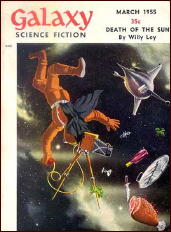
I then spent the rest of the convention buying original art. I’ve always wanted a GALAXY cover painting from the period when I started to read the magazine. I bought the cover for March 1955 by Mel Hunter. I also found a nice preliminary cover by Kelly Freas for ANALOG. Moving to other tables I manage to buy two Norman Saunders illustrations for the men’s adventure magazines. Unfortunately they do not depict such crazy scenes as Nazis partying with girls but then again I would not be able to afford such great art.
Art dealer Fred Taraba had many interesting paintings but I managed to control my greed and addiction and limited myself to a nice painting showing a woman screaming in a library. Sort of reminds me of the typical reaction from the non-collecting spouse when they realize they have married a Book Collector! This painting is by Maurice Thomas and was used as the cover on a 10 cent Dell paperback, DEATH WALKS THE MARBLE HALLS by Lawrence Blochman. It also was reprinted in the NEW YORKER for August 19, 1996.
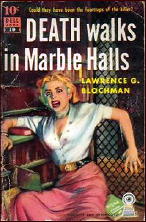
I also found a nice illustration by Edd Cartier titled “Framed For Murder.” Somehow I’ve managed to accumulate five of these Cartier drawings over the years. One of biggest finds was a set of 20 illustrations by Lynd Ward, who was an early graphic novelist. My first greedy thought was to buy all 20 but since they were priced at $500 each, I started to hesitate and before I knew it paperback collector, Tom Lesser had clutched two of them. Then I decided to buy only five of them at a discounted price of $450 each. All 20 are from one of the greatest ghost story collections ever, THE HAUNTED OMNIBUS edited by Alexander Laing.
But my biggest discovery was a large piece of art by Howard Wandrei. The brother of Donald Wandrei, Howard is known in pulp circles for his short stories written for such magazines as DETECTIVE FICTION WEEKLY, SPICY DETECTIVE, WEIRD TALES, UNKNOWN, etc. However his real claim to fame may very well turn out to be his strange, unusual, and bizarre outsider art. I’ve been thinking about buying this piece, which is impossible to describe, for two years, ever since I first saw it at the 2011 Windy City.
In addition to the fabulous dealer’s room, there also was a large art exhibit, mainly taken from the collections of Doug Ellis, Deb Fulton, and Bob Weinberg. There were a couple of panels discussing Sax Rohmer and Fu Manchu and Science Fiction and Bookselling. Unfortunately I was so busy partying, drinking and having a fine old time with my collector pals, that I missed the panels. As I’ve said before, one of the great things about Windy City and PulpFest are the friends and contacts that lead to long friendships and future deals.
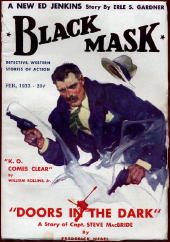
The film programming was handled by film expert, Ed Hulse and was of great interest. The serial DRUMS OF FU MANCHU was shown as well as several episodes from the great Boris Karloff THRILLER TV show. Ed also had the new issue of BLOOD N THUNDER magazine, which is a must buy for all magazine and film collectors. Check out his Murania Press website for news of upcoming publications.
Actually I did find a major pulp want now that I think of it. I recently obtained the February 1933 BLACK MASK cover painting and was pleased to find the magazine in the dealer’s room. The auction this year was one of the best ever held by Windy City. Friday night saw over 200 lots sold from the estate of Jerry Weist. I just added up the amounts paid for the lots and the total was over $43,000 for Friday. The Saturday auction also was of interest. A complete set of PLANET STORIES in very nice shape was auctioned off in several lots. But the main magazine title was the many issues of ALL STORY(1905-1920). These issues brought the highest prices and many had Edgar Rice Burroughs stories.
I’m closing in on a complete set of ALL STORY and need only 4 issues. Since many issues of this magazine are now over 100 years old, it is getting hard to find copies. But the auction had one of the four I needed, the July 7, 1917 issue. But I had to drop out when the bidding hit $950. Artwork is more interesting at that price and it’s difficult to justify paying hundreds for magazines. A friend of mine paid $900 for a pulp at the Frank Robinson auction and read it in about an hour. $900 for an hour’s reading? And I firmly believe these magazines should be read. I simply do not understand collectors who do not read but pay such high prices for issues.
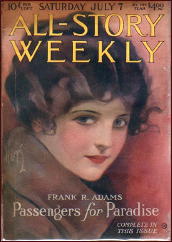
Jack Cullers provided me with some nostalgia. He found Rusty Hevelin’s copy of the June 12, 1972 St. Louis Globe-Democrat. In an article about the first Pulpcon, titled “Pulp magazine may fade, but never the memories” there is a photo of Edward Kessell, Rusy Hevelin, and Mrs Walker Martin, all looking at a Graves Gladney painting for THE SHADOW magazine. 41 years ago and I’m still at it!
Doug Ellis told me Sunday afternoon that the attendance had reached a new high level of 488. Almost 500 attendees and a new record that the old Pulpcon never came near. In this day of electronic gadgets and e-books, that is quite an achievement. So there is hope for the collectors of books and magazines afterall.
Monday morning the 5 of us, now known as The Publisher, The Collector, The Dealer, The Reader, and The Loser, piled into the van with hundreds of books, magazines, and artwork. Somehow we made it back to NJ despite one of us almost being arrested by a state trooper. It’s too strange a tale to tell.
Next up? PulpFest in three months! Details at pulpfest.com. See you there…
[UPDATE] 04-19-13. Thanks to pulp collector/dealer Dave Kurzman, some photos of the proceedings:
1. Long time pulp collector Digges La Touche sifting for nuggets while sitting on the floor.
2. Ed Hulse and Walker Martin keeping a close eye on the traffic across the way:
For Ed’s own comprehensive commentary on the weekend’s activities, go here.
[UPDATE] 06-20-13. Here is a link that shows two pages of photos from Windy City. Mainly about the art but interesting just the same:
http://www.comicartfans.com/galleryroom.asp?gsub=144236
